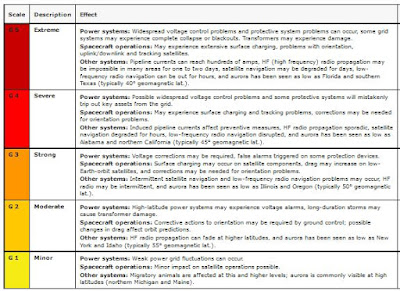NOAA CME UPDATE: The following statement was posted overnight by the NOAA Space Weather Prediction Center.
published: Thursday, September 07, 2017 02:17 UTC
The G3 (Strong) geomagnetic storm watch for the 7 September UTC-day remains in effect due to coronal mass ejection (CME) arrival and effects from the 4 September CME. Additionally, a G3 Watch is now in effect for the 8 and 9 September UTC-days in anticipation of the arrival of another CME associated with the X9.3 flare (R3-Strong radio blackout) on 6 September at 1202 UTC (0802 ET). Analysis indicates likely CME arrival late on 8 September into early 9 September. Keep checking our SWPC website for updates to the forecast.
#12,748
A little past 8am EDT (Sept 6th) the sun unleashed a major (X9.3) solar flare, one which was preceded by an X2.2 flare overnight and a smaller M class flare yesterday. A moderate CME (coronal mass ejection) is expected to arrive tonight from yesterday's flare, and we are awaiting analysis of this mornings (larger) flares to see if a CME was produced.
We've discussed the risks from space weather before (see USGS: Preparing The Nation For Severe Space Weather & Executive Order: Coordinating Efforts to Prepare the Nation for Space Weather Events), and these are very real threats that our government takes seriously.It is too soon to tell what, if any, impact today's solar flares will have on our power grid, but some disruptions have already been reported in shortwave and GPS systems.
Despite some of the more apocalyptic messages on social media this morning, this does not appear to be a `Carrington Event' redux, nor does it come anywhere near the intensity of the November 2003 Halloween flare (estimated X35) which caused power outages in northern Europe.That said, additional flares are possible, and every CME is different, depending on density, speed, and direction. NASA has released the following statement, and will update the situation once CME models are run and analyzed.
Sept. 6, 2017
Two Significant Solar Flares Imaged by NASA's SDO
The sun emitted two significant solar flares on the morning of Sept. 6, 2017. The first peaked at 5:10 a.m. EDT and the second, larger flare, peaked at 8:02 a.m. EDT. NASA’s Solar Dynamics Observatory, which watches the sun constantly, captured images of both events. Solar flares are powerful bursts of radiation.
Harmful radiation from a flare cannot pass through Earth's atmosphere to physically affect humans on the ground, however — when intense enough — they can disturb the atmosphere in the layer where GPS and communications signals travel.
To see how this event may affect Earth, please visit NOAA's Space Weather Prediction Center at http://spaceweather.gov, the U.S. government's official source for space weather forecasts, alerts, watches and warnings.
The first flare is classified as an X2.2 flare and the second is an X9.3 flare. X-class denotes the most intense flares, while the number provides more information about its strength. An X2 is twice as intense as an X1, an X3 is three times as intense, etc.
Both flares erupted from an active region labeled AR 2673, which also produced a mid-level solar flare on Sept. 4, 2017. The X9.3 flare was the largest flare so far in the current solar cycle, the approximately 11-year-cycle during which the sun’s activity waxes and wanes.
The current solar cycle began in December 2008, and is now decreasing in intensity and heading toward solar minimum. This is a phase when such eruptions on the sun are increasingly rare, but history has shown that they can nonetheless be intense. The radio black out from this particular flare is already passed, and http://spaceweather.gov has more details.
Updates will be provided as needed.
Additional imagery at: https://svs.gsfc.nasa.gov/12706
Banner image: NASA's Solar Dynamics Observatory captured this image of a significant solar flare — as seen in the bright flash on the lower right on Sept. 6, 2017. The image shows a subset of extreme ultraviolet light that highlights the extremely hot material in flares and which is typically colorized in red. Credit: NASA/Goddard/SDO
For now NASA is predicting G3 (strong) Geomagnetic storm conditions are possible tonight and tomorrow, which they describe as:
G3 (Strong) Geomagnetic Storm ImpactsPower systems: Voltage corrections may be required, false alarms triggered on some protection devices.
Spacecraft operations: Surface charging may occur on satellite components, drag may increase on low-Earth-orbit satellites, and corrections may be needed for orientation problems.More about the NOAA Space Weather Scales
Other systems: Intermittent satellite navigation and low-frequency radio navigation problems may occur, HF radio may be intermittent, and aurora has been seen as low as Illinois and Oregon (typically 50° geomagnetic lat.).


